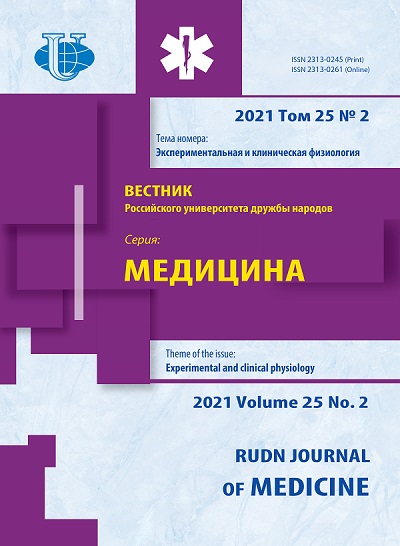Functional interaction of chewing muscles in children with dentoalveolar system anomalies
- Авторлар: Kosolapova I.V.1, Dorokhov E.V.1, Kovalenko M.E.1, Lesnikov R.V.2
-
Мекемелер:
- Voronezh State Medical University
- Budget Healthcare Institution of Voronezh region «Children’s Dental Clinic № 2»
- Шығарылым: Том 25, № 2 (2021): EXPERIMENTAL AND CLINICAL PHYSIOLOGY
- Беттер: 136-146
- Бөлім: CLINICAL PHYSIOLOGHY
- URL: https://journal-vniispk.ru/2313-0245/article/view/319955
- DOI: https://doi.org/10.22363/2313-0245-2021-25-2-136-146
- ID: 319955
Дәйексөз келтіру
Толық мәтін
Аннотация
Relevance. The focus of modern dental treatment not only on the elimination of aesthetic, but also functional disorders requires an understanding of the functional conjugation of the chewing muscles, the possibility of interprognosis of parameters. Objective. Assess the functional relationship between the tone of the chewing muscles proper and the bioelectric activity of the temporal and sublingual muscle groups in children with anomalies of the dentoalveolar system. Materials and Methods. The study involved 36 patients of Children’s Clinical Dental Clinic No. 2 of Voronezh, aged 6 to 12 years, who had not previously received orthodontic treatment and had distal occlusion anomalies. Evaluation of the bioelectric activity of temporal and sublingual muscles was carried out using surface electromyography on the Electromyograph Dental apparatus (Taganrog, Russia), the Chewing General sample. Evaluation of the tone of the chewing muscles proper was carried out using the Mioton-3C device in a state of physiological rest of the lower jaw. Statistical processing was carried out using Microsoft Excel, version 7.0 and the statistical programs SPSS Statistics 21 and STATISTICA 7. Results and Discussion. Correlation analysis revealed the presence of 4 weak positive, 2 weak negative, 14 moderate positive, 3 moderate negative, and 1 noticeable positive correlation between the tone of the right chewing muscle proper and the parameters of the bioelectric activity of the right and left temporal and sublingual muscles. Correlation analysis revealed the presence of 5 weak positive, 7 weak negative, 9 moderate negative correlations between the tone of the left chewing muscle proper and the parameters of bioelectric activity of the right and left temporal and sublingual muscles. Conclusion. A greater effect of the tone of the right chewing muscle on the bioelectric activity of temporal and sublingual muscles was found compared to the tone of the left chewing muscle itself. 27 equations have been derived that can be used as predictive models for calculating the tone of right and left chewing muscles proper depending on the indicators of bioelectric activity of temporal and sublingual muscles.
Негізгі сөздер
Авторлар туралы
I. Kosolapova
Voronezh State Medical University
Хат алмасуға жауапты Автор.
Email: irenecherry@yandex.ru
ORCID iD: 0000-0002-9779-7882
Voronezh, Russian Federation
E. Dorokhov
Voronezh State Medical University
Email: irenecherry@yandex.ru
ORCID iD: 0000-0002-2096-411X
Voronezh, Russian Federation
M. Kovalenko
Voronezh State Medical University
Email: irenecherry@yandex.ru
ORCID iD: 0000-0001-8841-5574
Voronezh, Russian Federation
R. Lesnikov
Budget Healthcare Institution of Voronezh region «Children’s Dental Clinic № 2»
Email: irenecherry@yandex.ru
ORCID iD: 0000-0002-8296-107X
Voronezh, Russian Federation
Әдебиет тізімі
- Ippolitov YA, Bondareva EN, Tatarintsev MM, Alireza MA, Lesnikov RV. Personified orthodontic treatment of adults with malocclusions and deformations in dentition depending on the degree of caries resistance of the dental enamel // International journal of pediatrics. 2020;8(10):12143-50. doi: 10.22038/ijp.2020.49505.3961
- Santos AC Dos, Silva CAB da. Surface electromyography of masseter and temporal muscles with use percentage while chewing on candidates for gastroplasty. Arquivos brasileiros de cirurgia digestiva. 2016;29(1):48-52. doi: 10.1590/0102-6720201600S10013
- Gadotti I, Hicks K, Koscs E, Lynn B, Estrazulas J, Civitella F. Electromyography of the masticatory muscles during chewing in different head and neck postures - A pilot study. Journal of oral biology and craniofacial research. 2020;10(2):23-7. doi: 10.1016/j.jobcr.2020.02.002
- Prado DG de A, Berretin-Felix G, Migliorucci RR et al. Effects of orofacial myofunctional therapy on masticatory function in individuals submitted to orthognathic surgery: a randomized trial. Journal of Applied Oral Science. 2018;26:164. doi: 10.1590/1678-7757-2017-0164
- Luo Z, Lo WLA, Bian R, Wong S, Li L. Advanced quantitative estimation methods for spasticity: a literature review. Journal of International Medical Research. 2019;48(3). doi: 10.1177/0300060519888425
- Payenok A V, Morozova OG, Payenok OS, Mitelman IM, Bilianskyi OY. Features of estimation of muscle tone and functional state of spinal motor neurons in patients with post-stroke spasticity on a background of a pharmacological correction. Wiadomosci lekarskie. 2019;72(10):1939-41.
- Kosolapova IV, Dorokhov EV, Kovalenko ME. Features of correlation of electromyographic and myotonometric studies in children with anomalies dentoalveolar system. J Volgogr State Med Univ. 2020;73(1):160-3. (In Russ).
- Uehara F, Hori K, Murakami K, Okawa J, Ono T. Differentiation of Feeding Behaviors Based on Masseter and Supra-Hyoid Muscle Activity. Frontiers in physiology. 2020;11:618. doi: 10.3389/fphys.2020.00618
- Khudoroshkov UG, Karagozyan YS. Valuation of functional condition of musticatory muscles of patiens with malocclusion combined with tmj dysfunction. Modern Probl Sci Educ. 2016;4:146-51. (In Russ).
- Abramyan AA, Dyakonova ED, Persin LS, Porohin AYu. Evaluation of change in the tone of the chewing muscles depending on the position of the patient’s body. Dentistry as a Science. 2013;3(9):1076. (In Russ).
- Khudoroshkov UG, Karagozyan YS. Valuation of functional condition of musticatory muscles of patiens with malocclusion combined with tmj dysfunction. Modern Problems of Science and Education. 2016;4:146-51. (In Russ).
- Tokarevich IV. The analysis of the state of masseter and temporalis muscles with myofunctional disorders in children 7-8 years old and the evaluation of the effectiveness of orthodontic correction methods. Vestnik BGMU. 2013;4:10-22. (In Russ).
Қосымша файлдар








